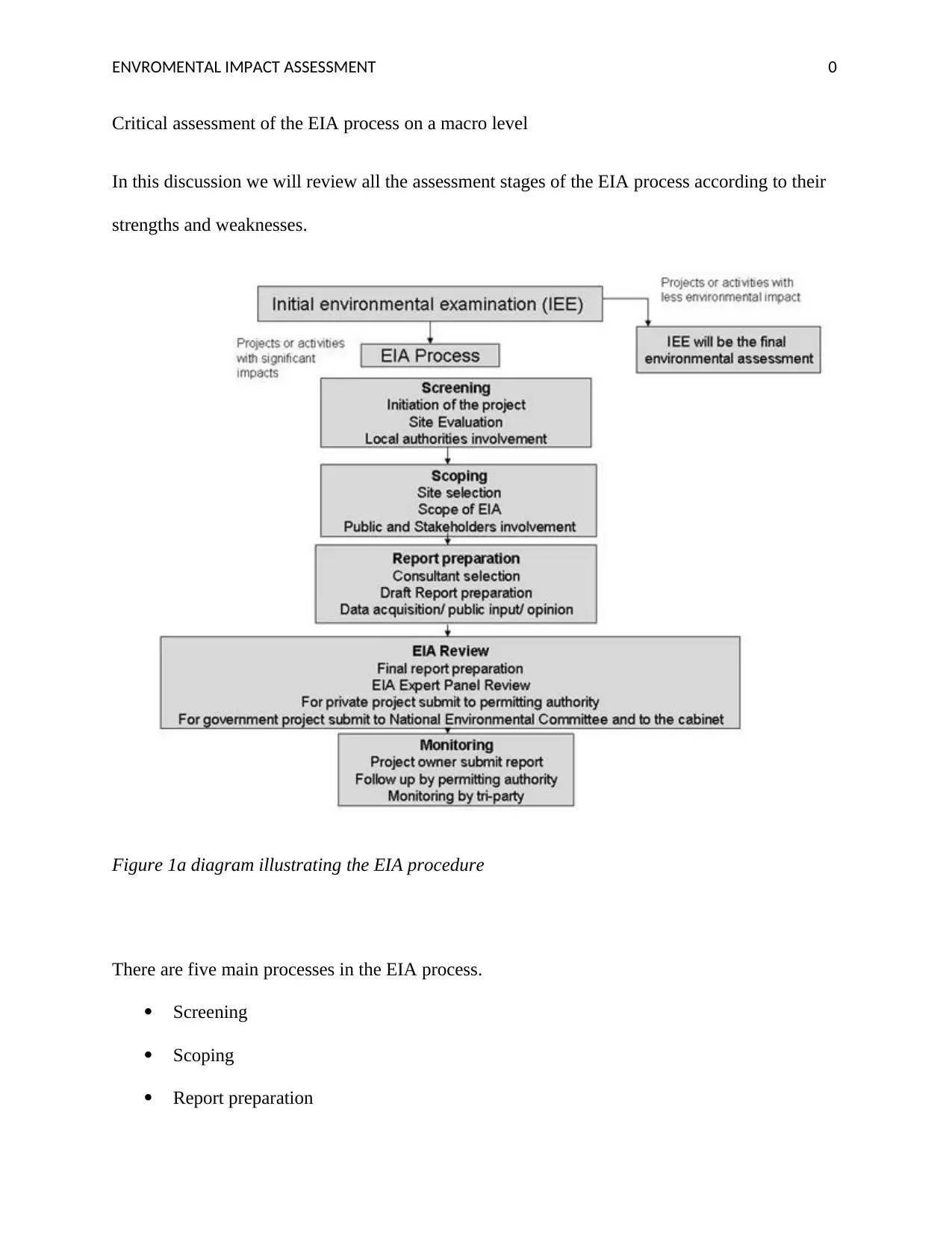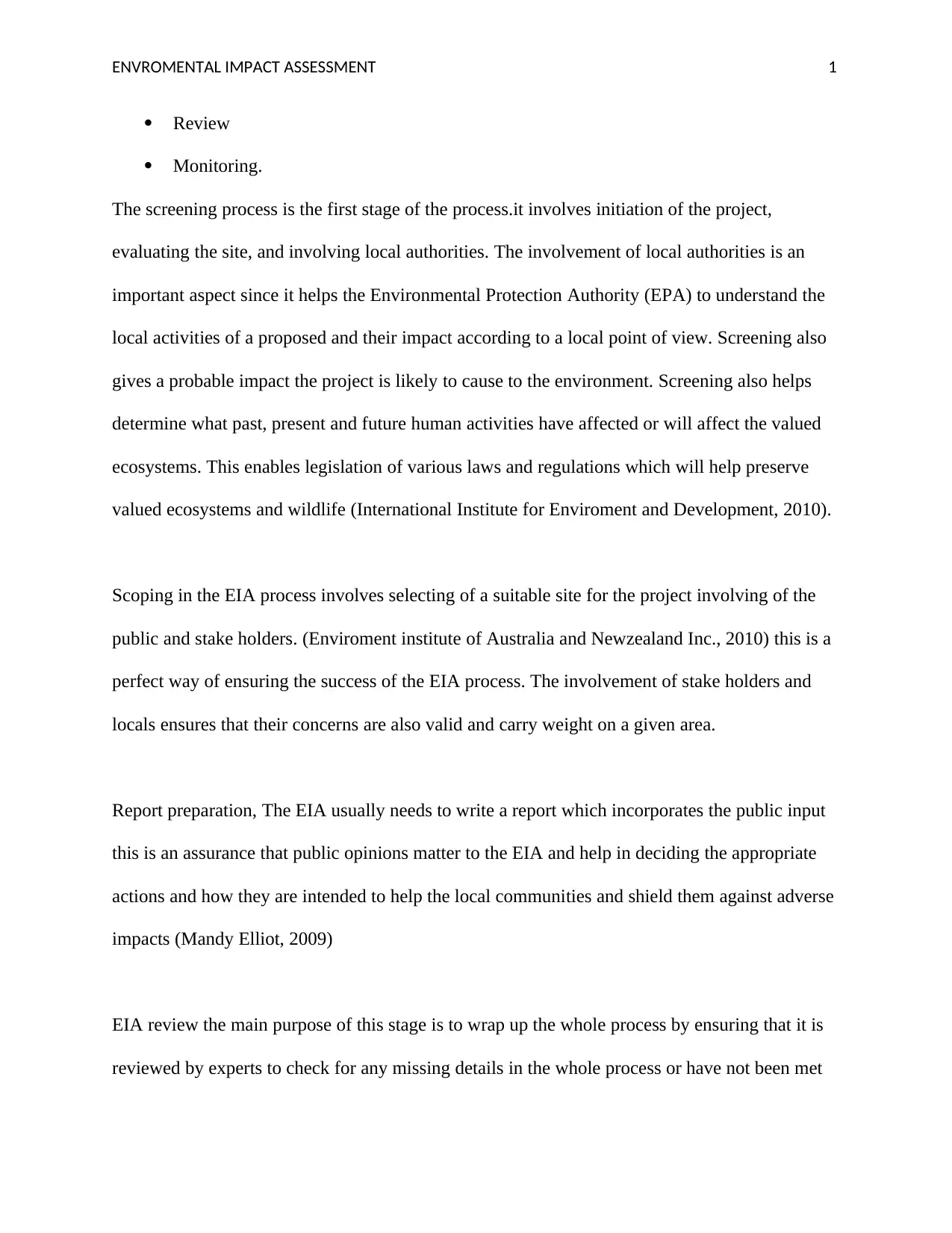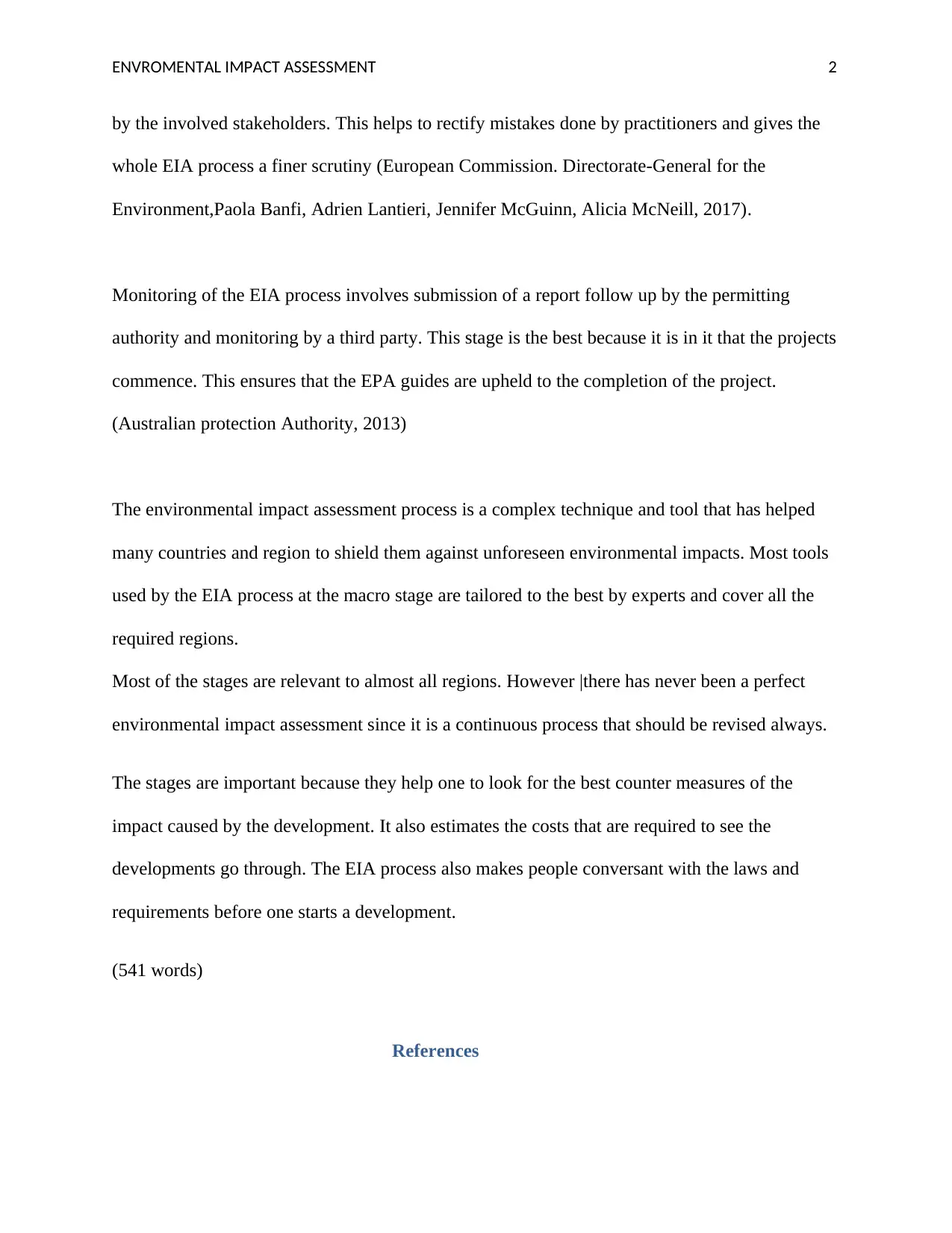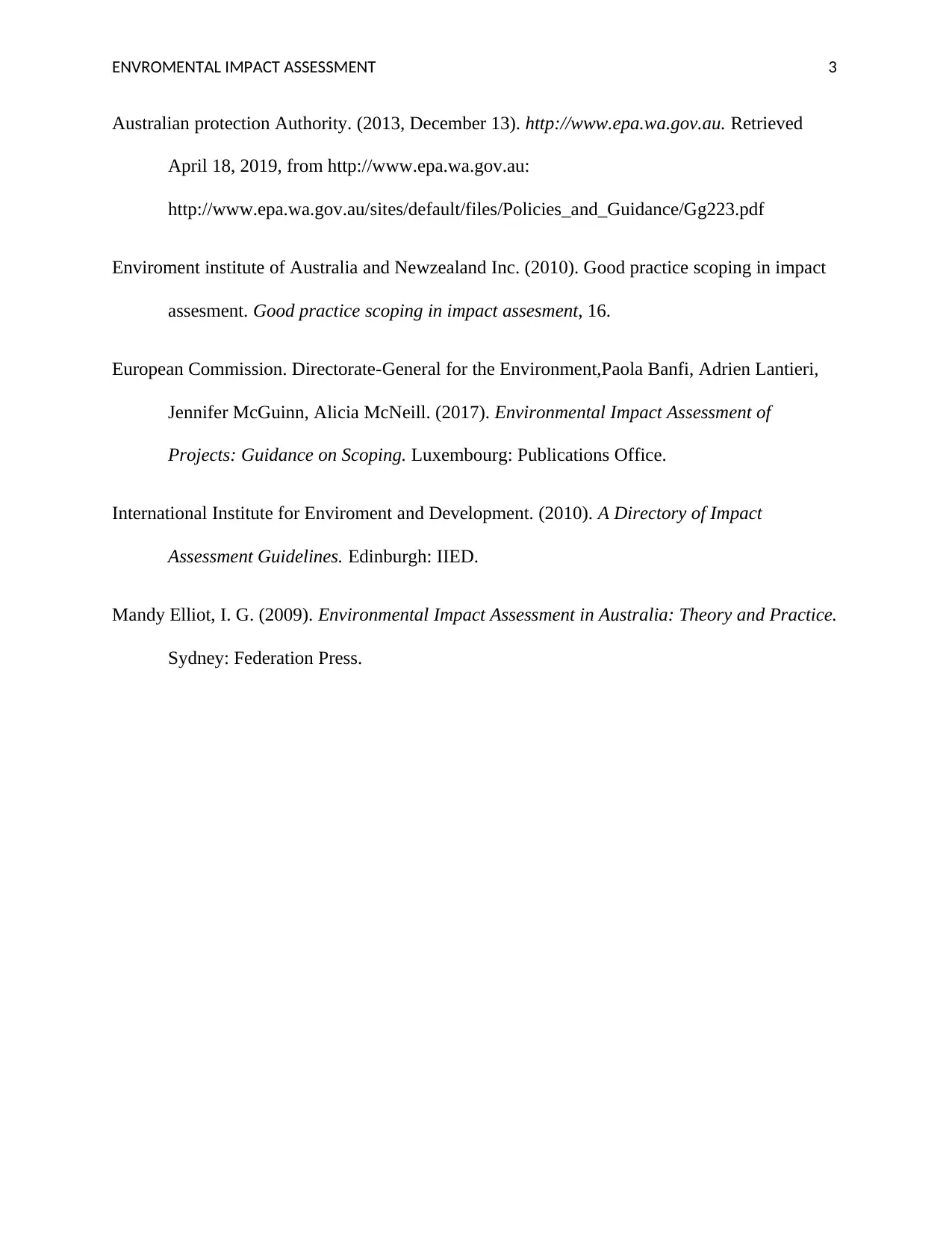Environmental Impact Assessment (EIA) Process: Critical Evaluation
VerifiedAdded on 2023/01/20
|4
|758
|25
Report
AI Summary
This report provides a critical review of the Environmental Impact Assessment (EIA) process, analyzing its various stages including screening, scoping, report preparation, review, and monitoring. The assessment examines the strengths and weaknesses of each stage, highlighting the importance of stakeholder involvement and the need for continuous improvement. The report references relevant literature and emphasizes the role of the EIA process in protecting ecosystems and ensuring sustainable development. It also explores the application of best practices in EIA, suggesting improvements for enhancing the effectiveness of environmental impact assessments at a macro level. The report concludes by underscoring the continuous nature of the EIA process and its adaptability to various regions and contexts.

ENVROMENTAL IMPACT ASSESSMENT 0
Critical assessment of the EIA process on a macro level
In this discussion we will review all the assessment stages of the EIA process according to their
strengths and weaknesses.
Figure 1a diagram illustrating the EIA procedure
There are five main processes in the EIA process.
Screening
Scoping
Report preparation
Critical assessment of the EIA process on a macro level
In this discussion we will review all the assessment stages of the EIA process according to their
strengths and weaknesses.
Figure 1a diagram illustrating the EIA procedure
There are five main processes in the EIA process.
Screening
Scoping
Report preparation
Paraphrase This Document
Need a fresh take? Get an instant paraphrase of this document with our AI Paraphraser

ENVROMENTAL IMPACT ASSESSMENT 1
Review
Monitoring.
The screening process is the first stage of the process.it involves initiation of the project,
evaluating the site, and involving local authorities. The involvement of local authorities is an
important aspect since it helps the Environmental Protection Authority (EPA) to understand the
local activities of a proposed and their impact according to a local point of view. Screening also
gives a probable impact the project is likely to cause to the environment. Screening also helps
determine what past, present and future human activities have affected or will affect the valued
ecosystems. This enables legislation of various laws and regulations which will help preserve
valued ecosystems and wildlife (International Institute for Enviroment and Development, 2010).
Scoping in the EIA process involves selecting of a suitable site for the project involving of the
public and stake holders. (Enviroment institute of Australia and Newzealand Inc., 2010) this is a
perfect way of ensuring the success of the EIA process. The involvement of stake holders and
locals ensures that their concerns are also valid and carry weight on a given area.
Report preparation, The EIA usually needs to write a report which incorporates the public input
this is an assurance that public opinions matter to the EIA and help in deciding the appropriate
actions and how they are intended to help the local communities and shield them against adverse
impacts (Mandy Elliot, 2009)
EIA review the main purpose of this stage is to wrap up the whole process by ensuring that it is
reviewed by experts to check for any missing details in the whole process or have not been met
Review
Monitoring.
The screening process is the first stage of the process.it involves initiation of the project,
evaluating the site, and involving local authorities. The involvement of local authorities is an
important aspect since it helps the Environmental Protection Authority (EPA) to understand the
local activities of a proposed and their impact according to a local point of view. Screening also
gives a probable impact the project is likely to cause to the environment. Screening also helps
determine what past, present and future human activities have affected or will affect the valued
ecosystems. This enables legislation of various laws and regulations which will help preserve
valued ecosystems and wildlife (International Institute for Enviroment and Development, 2010).
Scoping in the EIA process involves selecting of a suitable site for the project involving of the
public and stake holders. (Enviroment institute of Australia and Newzealand Inc., 2010) this is a
perfect way of ensuring the success of the EIA process. The involvement of stake holders and
locals ensures that their concerns are also valid and carry weight on a given area.
Report preparation, The EIA usually needs to write a report which incorporates the public input
this is an assurance that public opinions matter to the EIA and help in deciding the appropriate
actions and how they are intended to help the local communities and shield them against adverse
impacts (Mandy Elliot, 2009)
EIA review the main purpose of this stage is to wrap up the whole process by ensuring that it is
reviewed by experts to check for any missing details in the whole process or have not been met

ENVROMENTAL IMPACT ASSESSMENT 2
by the involved stakeholders. This helps to rectify mistakes done by practitioners and gives the
whole EIA process a finer scrutiny (European Commission. Directorate-General for the
Environment,Paola Banfi, Adrien Lantieri, Jennifer McGuinn, Alicia McNeill, 2017).
Monitoring of the EIA process involves submission of a report follow up by the permitting
authority and monitoring by a third party. This stage is the best because it is in it that the projects
commence. This ensures that the EPA guides are upheld to the completion of the project.
(Australian protection Authority, 2013)
The environmental impact assessment process is a complex technique and tool that has helped
many countries and region to shield them against unforeseen environmental impacts. Most tools
used by the EIA process at the macro stage are tailored to the best by experts and cover all the
required regions.
Most of the stages are relevant to almost all regions. However |there has never been a perfect
environmental impact assessment since it is a continuous process that should be revised always.
The stages are important because they help one to look for the best counter measures of the
impact caused by the development. It also estimates the costs that are required to see the
developments go through. The EIA process also makes people conversant with the laws and
requirements before one starts a development.
(541 words)
References
by the involved stakeholders. This helps to rectify mistakes done by practitioners and gives the
whole EIA process a finer scrutiny (European Commission. Directorate-General for the
Environment,Paola Banfi, Adrien Lantieri, Jennifer McGuinn, Alicia McNeill, 2017).
Monitoring of the EIA process involves submission of a report follow up by the permitting
authority and monitoring by a third party. This stage is the best because it is in it that the projects
commence. This ensures that the EPA guides are upheld to the completion of the project.
(Australian protection Authority, 2013)
The environmental impact assessment process is a complex technique and tool that has helped
many countries and region to shield them against unforeseen environmental impacts. Most tools
used by the EIA process at the macro stage are tailored to the best by experts and cover all the
required regions.
Most of the stages are relevant to almost all regions. However |there has never been a perfect
environmental impact assessment since it is a continuous process that should be revised always.
The stages are important because they help one to look for the best counter measures of the
impact caused by the development. It also estimates the costs that are required to see the
developments go through. The EIA process also makes people conversant with the laws and
requirements before one starts a development.
(541 words)
References
⊘ This is a preview!⊘
Do you want full access?
Subscribe today to unlock all pages.

Trusted by 1+ million students worldwide

ENVROMENTAL IMPACT ASSESSMENT 3
Australian protection Authority. (2013, December 13). http://www.epa.wa.gov.au. Retrieved
April 18, 2019, from http://www.epa.wa.gov.au:
http://www.epa.wa.gov.au/sites/default/files/Policies_and_Guidance/Gg223.pdf
Enviroment institute of Australia and Newzealand Inc. (2010). Good practice scoping in impact
assesment. Good practice scoping in impact assesment, 16.
European Commission. Directorate-General for the Environment,Paola Banfi, Adrien Lantieri,
Jennifer McGuinn, Alicia McNeill. (2017). Environmental Impact Assessment of
Projects: Guidance on Scoping. Luxembourg: Publications Office.
International Institute for Enviroment and Development. (2010). A Directory of Impact
Assessment Guidelines. Edinburgh: IIED.
Mandy Elliot, I. G. (2009). Environmental Impact Assessment in Australia: Theory and Practice.
Sydney: Federation Press.
Australian protection Authority. (2013, December 13). http://www.epa.wa.gov.au. Retrieved
April 18, 2019, from http://www.epa.wa.gov.au:
http://www.epa.wa.gov.au/sites/default/files/Policies_and_Guidance/Gg223.pdf
Enviroment institute of Australia and Newzealand Inc. (2010). Good practice scoping in impact
assesment. Good practice scoping in impact assesment, 16.
European Commission. Directorate-General for the Environment,Paola Banfi, Adrien Lantieri,
Jennifer McGuinn, Alicia McNeill. (2017). Environmental Impact Assessment of
Projects: Guidance on Scoping. Luxembourg: Publications Office.
International Institute for Enviroment and Development. (2010). A Directory of Impact
Assessment Guidelines. Edinburgh: IIED.
Mandy Elliot, I. G. (2009). Environmental Impact Assessment in Australia: Theory and Practice.
Sydney: Federation Press.
1 out of 4
Related Documents
Your All-in-One AI-Powered Toolkit for Academic Success.
+13062052269
info@desklib.com
Available 24*7 on WhatsApp / Email
![[object Object]](/_next/static/media/star-bottom.7253800d.svg)
Unlock your academic potential
Copyright © 2020–2025 A2Z Services. All Rights Reserved. Developed and managed by ZUCOL.




